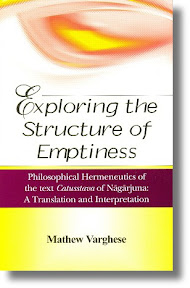Exploring the Structure of Emptiness
Varghese, Mathew:
Exploring the Structure of Emptiness : Philosophical Hermeneutics of the text Catusstava of Nāgārjuna ; a Translation and Interpretation / Mathew Varghese. - New Delhi : Sanctum Books, 2012. - 413 S.
Einheitssachtitel des enthaltenen Werks: Catuḥstava / Nāgārjuna <engl.>
ISBN 978-81-909950-1-6
Rs. 995
US$ 23,95 (Munshiram Manoharlal)
US$ 24,88 (Sanctum Books)
US$ 47,35 (D.K. Agencies)
US$ 56,70 (Bagchee)
DDC: 294.392; 181.04392
Beschreibung
Nagarjuna is one of the finest philosophers who ever lived. This second century Buddhist philosopher from south India is known for his criticism on speculative theories and viewpoints. But his name is better known for introducing the idea of emptiness (sunyata), a philosophical concept that had hugely influenced the discourses of Eastern philosophy, religion, and culture for about 2000 years. Nagarjuna cleverly introduced emptiness (sunyata), into Buddhist discourses to explain its central philosophy: the philosophy of Middle Path. Through the negative mode of argumentation, he taught how we naturally get trapped into extreme viewpoints and speculate on them. His philosophy of Middle Path (Madhyamika) explains the progress of human reasoning moving in its natural course avoiding extreme viewpoints for finding harmony and freedom. During the second century, in a different milieu, Nagarjuna warned his students about the dangers of speculative thought created out of extreme viewpoints and philosophical doctrines. He taught them to look into the structures of such doctrines critically by using negation to know what the truth is. Therefore, the philosophical idea of emptiness (sunyata) is not the end of negation assuming perfect nihilism, but teaching us that it would work like medicine for removing all our ignorance. More precisely, it is like zero (sunya) in mathematics, a number with an undefined value, but real numbers find newer values by associating with it. It is a philosophical tool that helps us control our alleged fears, anger, petty hatred, etc., by invoking the natural course of human compassion (karuna) for us to live and die naturally. Therefore, the structure of emptiness is the philosophy of Middle Path. [Verlagsinformation]
Inhalt
1. The Text and the Technique of Discourse
2. Philosophical Function of Emptiness (śūnyata): The Techne of "Denials and Deny Denials"
3. Interpreting Śūnyata: A Process for Caring the Self
4. The Conception of the Pure Knowledge and Knowledge
5. Phenomenal Experience and the Object
6. Conception of Emptiness and the Object
7. Emptiness and Philosophy of the Middle: Remaking the Concept of Man
APPENDICES
Text: Catusstava by Nagarjuna: English translation with Notes
I. Lokātītastava
II. Niraupamyastava
III. Acintyastava
IV. Paramārthastava
Bibliography
Index.
Autor
MATHEW VARGHESE is a scholar of classical Buddhist philosophy and comparative Philosophical Hermeneutics especially working on Emptiness and Negative dialectics. He is a research fellow and teacher at The Eastern Institute (Toho Gakuin), Tokyo. He also conducts various courses on Bilingual Communication and comparative philosophy at Wako University, Kangawa University and Aoyama Gakuin University in Tokyo. Homepage.
Quellen: Sanctum Books; D.K. Agencies; Bagchee; Munshiram Manoharlal
Bildquelle: Sanctum Books
Bibliographie: [1]
References
Ähnlich
- Kritzer: Garbhavakrantisutra
- Habata: Mahāparinirvāṇa-mahāsūtra - Critical Edition
- The Nirvana Sutra ... Vol. 1
- Kim: La carrière du Bodhisattva
- Santideva and Bodhicaryavatara
- Mining for Wisdom within Delusion
- Gilgit Lotus Sutra manuscripts from the National Archives of India
- Avatamsaka Buddhism in East Asia
- Luminous Bliss
- Groundless Paths

